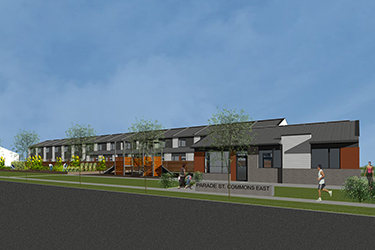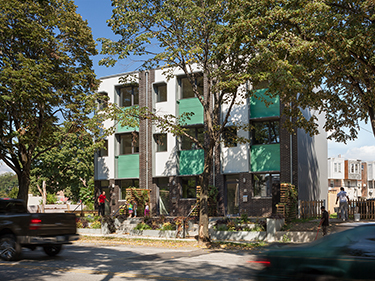|
Subscribe / Renew |
|
|
Contact Us |
|
| ► Subscribe to our Free Weekly Newsletter | |
| home | Welcome, sign in or click here to subscribe. | login |
Environment
| |
 |
March 24, 2016
‘Passive house’ design can make housing more affordable
Nicholson Kovalchick Architects

Weyand
|
As Seattle gets ready to deliver 20,000 units of new affordable housing, we should ask if it can deliver the kind of high-quality, energy-efficient and low-maintenance housing that everyone deserves.
Most of the new affordable housing in Seattle will be underwritten with both state Low Income Housing Tax Credits (LIHTC) and the soon-to-be-implemented city of Seattle linkage fees.
These funding agencies, being strong proponents of social justice, should take note of recent successful affordable housing projects in Pennsylvania, which have been able to provide high-quality, healthy housing within state affordable-housing budgets.
Three years ago, Pennsylvania wanted to find a way to improve energy efficiency and construction quality in state-funded affordable housing projects, and landed on the “passive house” standard as the mechanism for achieving their desired gains.
Passive house refers to a voluntary standard of building design that reduces energy used for heating and cooling by up to 90 percent over code-minimum buildings. The passive house design methods of air-and-weather barriers, superinsulation and heat-recovery ventilation also create very healthy indoor air environments and reduce risk of rot and mold in buildings.
A year later the Pennsylvania Housing Finance Agency implemented an incentive program that included passive house energy benchmarks in its LIHTC application scoring. Their belief was that competition for state funds from nonprofit affordable housing developers would drive lower-energy, higher-quality projects.
In the first year, 20 percent of all awarded affordable housing projects in Pennsylvania were built to the passive house standard, which will result in 422 new high-performance affordable housing units. In the 2015 funding cycle, almost half of all proposed projects chose to pursue the standard.
Other states with affordable housing funding agencies have taken note, and currently nine other states, including New York, New Jersey, Ohio, Rhode Island, Massachusetts, Illinois, Connecticut, New Hampshire and Idaho, have included the passive house standard as an incentive in their own affordable housing funding selection criteria.
“Future-proofed” housing
Affordable housing developments are well suited to being high-performance passive house buildings for many reasons.
The first reason is that passive house buildings are much more efficient to heat and cool than conventional buildings, which lowers operating costs. Lower operating costs are very important for affordable-housing operators because rents are lower than market rate average, and they must keep operating costs in check to remain viable.
In fact, because electricity costs are rising faster than rents in many areas throughout the U.S., passive house buildings confer additional long-term financial viability to multifamily housing assets, often referred to as “future-proofing.”
The second reason that affordable housing developments are well suited to being passive house is that maintenance costs are lower. This derives from the air- and weather-tight exterior walls and roof, which prevent water intrusion as well as in-wall vapor condensation, eliminating the chances for rot and mold. Longer exterior system replacement schedules translates into lower reserve funds, and therefore lower operational costs.
Third, passive house interior spaces are much healthier than conventional buildings, which is just as important for affordable housing residents as it is to any other individual or family.
We believe that everyone should have access to safe, healthy, affordable homes. Spaces are more comfortable because the passive house enclosure and HVAC system keeps thermal and humidity swings within the human comfort range, and because the heat-recovery ventilation system used in passive house buildings provides constant, HEPA-filtered fresh air.
Lastly, apartments are more peaceful because continuous exterior insulation and high-quality windows and doors keep outside noise and odors away.
Need for state incentives
In Seattle, multifamily affordable housing buildings use significantly more energy than their market-rate counterparts across building sizes, according to the Seattle Office of Sustainability & Environment.
This has often been attributed to lower unit sizes and denser populations in affordable housing facilities. However, in the case of mid-rise buildings, the affordable housing facilities are on average 28 percent more dense, yet use 42 percent more energy, which cannot be attributed to population habits alone.
If the passive house standard is incentivized at our state and local levels, it would be reasonable to expect — following Pennsylvania’s experience — that after four years, half of our new affordable housing stock would be performing at 18 EUI, or a full two-thirds less energy than was benchmarked in 2013.
We’ll need to build 8,000 units in four years’ time to stay on pace with the mayor’s housing challenge of 20,000 affordable units within 10 years. With a Pennsylvania-type passive house incentive system, at least half of the 8,000 units would be low-energy, low-operating cost, comfortable and healthy places to live for our community’s needy individuals and families.
The time is now to incentivize high-performance affordable housing in new construction, not later when we will have to go back and retrofit walls, roofs and foundations.
Seattle has long been seen as a progressive city when it comes to social and environmental justice. If we don’t adopt now what other states rightly see as a clearly progressive initiative to build quality affordable housing, then we will not even be able to call ourselves sensible followers, much less leaders, in the social and environmental justice movement.
Tim Weyand is CEO of Nicholson Kovalchick Architects.
Other Stories:
- Big-box store gets a second life after a green makeover
- Weyerhaeuser’s new headquarters will show off its wood products
- Developers who try to go green find money stands in their way
- Building operators add energy management to their repertoire
- Ballard fire station goes from energy hog to energy heaven
- South Lake Union’s ‘swale on Yale' is getting set to grow
- What is embodied carbon and why should we care?
- How sharing sit-stand desks will help Antioch be smaller and greener




